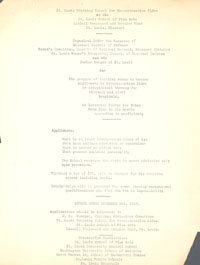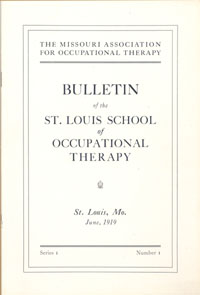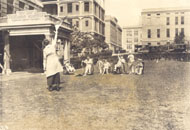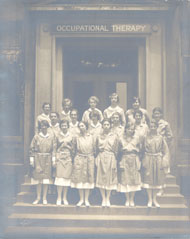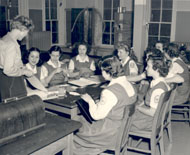Health Professions
Occupational Therapy in St. Louis
The health profession of occupational therapy emerged in the 1910s as the belief that engaging a patient’s mind and body quickened convalescence gained acceptance. The earliest phase of development was prompted by the tradition of women’s altruistic work with deprived or dependent populations and as arts and crafts enthusiasts. In the pre-war period women took domestic activities such as cloth production and basket weaving to institutional settings such as tuberculosis and children’s hospitals. During the First World War, reconstruction aides became invaluable members of the war effort, working in military hospitals both abroad and at home. The demand for workers to aid in the rehabilitation of soldiers physically and mentally disabled by the war prompted the founding of schools to train women in the skills and perspectives of both occupational and physical therapy.
In St. Louis, Rachel Stix Michael called a meeting on October 28, 1918 to discuss the possibility of training reconstruction aides for military hospitals. Mrs. Michael called together a number of people who she thought would be interested in developing this work as an activity of the Committee on Women’s Work of the St. Louis Women’s Committee of the Council of National Defense. At a meeting held November 4, 1918, a tentative curriculum for a training school was discussed. The name chosen for the school was the St. Louis Training School for Reconstruction Aides. Eleanor Clark Slagle, a founder of the American Occupational Therapy Association, visited St. Louis on November 7th and approved the group’s plans. Although the Armistice ending the First World War was signed on November 11, 1918, the group decided that the military needs for occupational therapy would continue and that the training of aides was still necessary. Miss Alice Dean was appointed director of the school on November 25th and the first class of students began on December 2, 1918. The St. Louis Training School for Reconstruction Aides was located in the St. Louis School of Fine Arts, on the main campus of Washington University, and was the first program in occupational therapy offered west of the Mississippi River. On December 14, 1918 the school’s name was changed to the St. Louis School of Occupational Therapy. A second class of students began on February 24, 1919. The first class of 12 women completed their course of instruction in May 1919.
The curriculum for the first class consisted of 40 hours of lectures in medical and socio-vocational topics, 9 weeks of hospital practice, and 9 weeks of craft classes. High school graduation was a prerequisite. By the start of the second class in February 1919, the curriculum had expanded to 12 weeks of hospital practice and 16 weeks of craft work. The third class began September 23, 1919, with the school relocating to 3510 Washington Avenue.
Plans were made to establish a statewide association as well as the training school. As a result, the Missouri Association for Occupational Therapy was established and chartered in June 1919, to demonstrate and promote occupational therapy and to standardize professional procedures. The Junior League of St. Louis, which had already established an occupational therapy workshop in the basement of St. Louis Children’s Hospital, gave the Association $5,000 to help finance the training school. Idelle Kidder was appointed director of the Missouri Association for Occupational Therapy in late June 1919. Geraldine Lermit assumed the directorship of the Association and training school in 1922.
 |
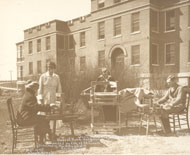 |
|
| Occupational therapists at the St. Louis City Hospital, ca. 1920 | Occupational therapists and patients, Robert Koch Hospital (for tubercular patients), 1922 |
Occupational therapy was inaugurated in the St. Louis City Hospital and in the Barnes Hospital during January 1919. Programs at the City Sanitarium and other local hospitals followed soon thereafter. In 1923 the Missouri Association for Occupational Therapy established a Home Service department which provided visiting therapists for post-hospital cases and homebound persons. The Association promoted the establishment of occupational therapy departments in hospitals throughout the state of Missouri, often directly supervising these departments until the individual hospitals were able to assume responsibility.
By the 1922-23 academic year, the St. Louis School of Occupational Therapy lengthened its course of instruction to one year. The School was moved again, this time to 4580 Scott Avenue, one of the buildings of the Washington University School of Medicine. By 1925 the course was again lengthened and covered a two-year period for those who were high school graduates. Adjustments were made in the course length for those who entered with college credit. The curriculum included such craft classes as bead work, rushmaking, celluloid work, gesso, parchment shades and rug making. Courses given by Washington University were also included. A diploma in Occupational Therapy was granted at the end of the two-year period.
In 1929 the School was moved to 4567 Scott Avenue to a building purchased by Dr. Malvern E. Clopton and presented to Washington University. Clopton was president of the Missouri Association for Occupational Therapy at the time.
In 1934, in order to meet growing demands in the professional field and because increased opportunities were available through the cooperation of Washington University, courses in recreation and group work were included in the curricular requirements. The name of the school was changed to the St. Louis School of Occupational and Recreational Therapy. Two degree programs were offered – a three-year course leading to a diploma in Occupational Therapy and a four-year course leading to the degree of bachelor of science in Education granted by Washington University. The diploma in Occupational Therapy granted by the St. Louis School of Occupational and Recreational Therapy was awarded upon completion of both the three- and four-year programs. At the time, nine months of practice work in occupational therapy was required in addition to the academic courses.
 |
| Rachel Stix Michael (center) and faculty of the St. Louis School of Occupational and Recreational Therapy, 1935 |
In 1936 Rachel Stix Michael died and bequeathed over $200,000 to Washington University, of which $150,000 was to be used to establish a professorship of Occupational Therapy in the Washington University School of Medicine. In 1938 a chair in Occupational Therapy was established and the director of the St. Louis School for Occupational and Recreational Therapy was appointed to it. Each successive director of the school has been appointed to the Elias Michael Professorship, named in honor of Rachel Stix Michael’s husband who died in 1913.
In 1945 the administration of the St. Louis School for Occupational and Recreational Therapy was assumed by Washington University. In February 1946 the school was established as the Department of Occupational Therapy in the Division of Auxiliary Medical Services of the Washington University School of Medicine. The three-year diploma course was discontinued after the school was established within the School of Medicine.
The two longest serving directors of the School were Geraldine Lermit (1922 to 1945) and Martha Matthews (1956 to 1975). Under Lermit’s direction, the course of instruction was lengthened and improved and a four-year bachelor’s degree course was introduced. The St. Louis School of Occupational Therapy strengthened its association with Washington University, culminating with the university taking over the administration of the school in 1945.
Martha Matthews was instrumental in developing the curriculum, increasing the basic science courses, reflecting the increasing emphasis on scientific research in the study of occupational therapy. Rehabilitation techniques dealing with prosthetics training, splint construction, daily living activities, spinal cord injuries and progressive neurological disorders were added to the curriculum as well. Matthews also helped plan the occupational therapy facilities at the Irene Walter Johnson Institute of Rehabilitation in 1959.
A graduate program was developed in 1977 to provide advanced training in practice and research. In October 1988 the academic program and clinical service were joined to form the Program in Occupational Therapy. It is through this union that the Program carries out its academic mission of research, education and community development, and its clinical mission of service and community education.
When the St. Louis Training School for Reconstruction Aides was founded in 1918, four other schools of comparative stature existed in the United States – the Henry B. Favill School of Occupations in Chicago, the Boston School of Occupational Therapy, the Philadelphia School of Occupational Therapy, and Milwaukee Downer College. The St. Louis school (now the Program in Occupational Therapy, Washington University School of Medicine) and the Boston School of Occupational Therapy, associated with Tufts University since 1945, remain in existence.
Return to OT/PT (Health Professions)
Return to Health Professions
Back to Top

